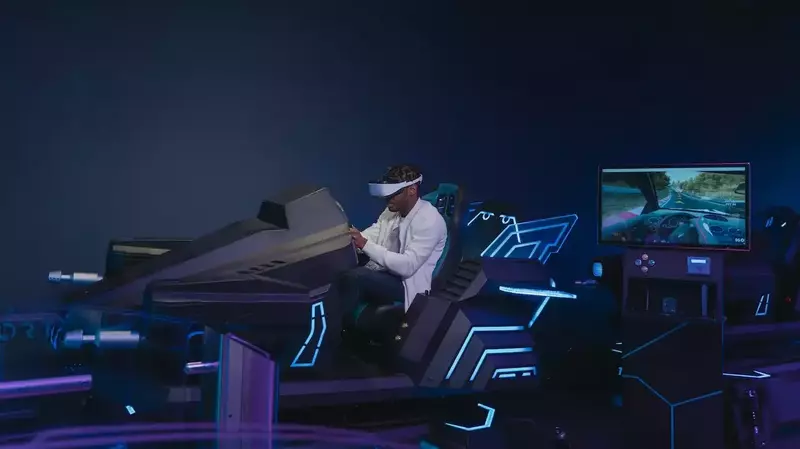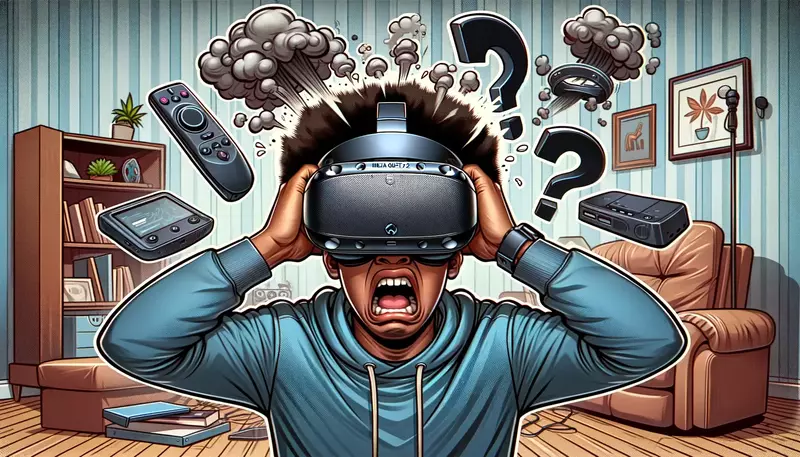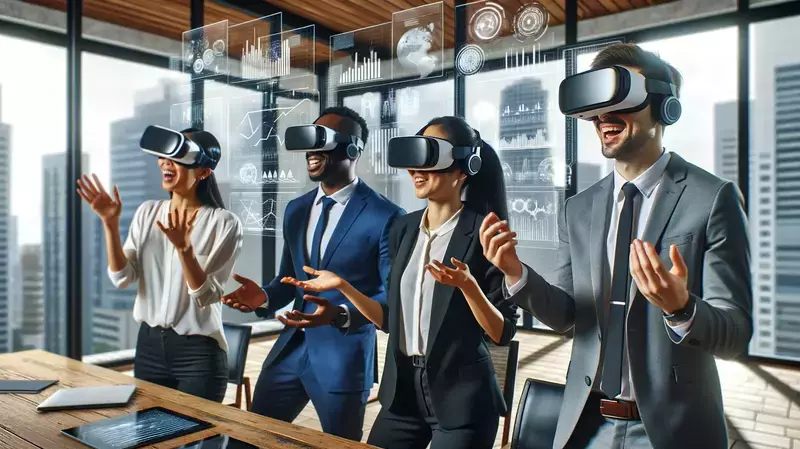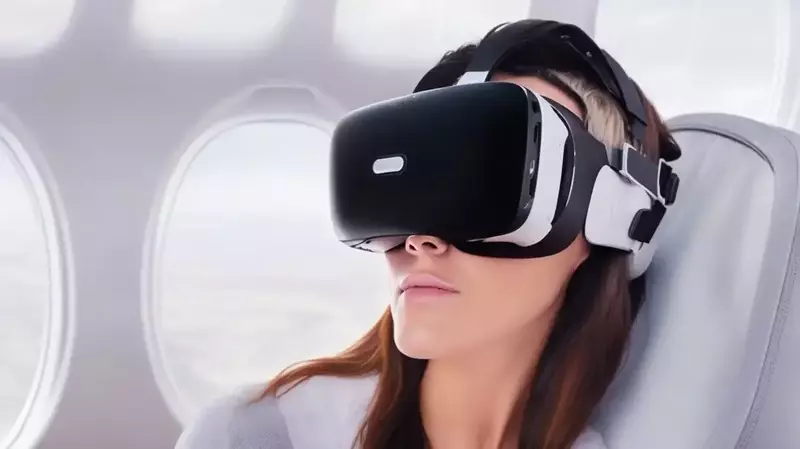This site contains affiliate links to products, and we may receive a commission for purchases made through these links.
Will we see full immersion virtual reality by 2039? As tech progresses at an incredible speed, it’s becoming more and more realistic to enter a completely immersive virtual reality.
In this blog post, we will delve into the fascinating realm of virtual reality (VR) and explore its potential for transforming our experiences in gaming, exploration, and learning.
To understand the distinction between VR and other digital forms of entertainment, we will start by exploring what virtual reality is. Next, we’ll evaluate the present state of VR tech and analyze how close we are to achieving total immersion. We will also identify some challenges that must be overcome before realizing this captivating vision.
Finally, as we ponder whether or not full immersion VR will become a reality by 2039, let’s envision what such an experience might look like and discuss ways in which society can prepare for this revolutionary leap forward in interactive media.

What is Virtual Reality?
Immersing users in a three-dimensional digital world, VR provides an incredibly lifelike experience that blurs the boundaries between reality and virtuality.
By wearing specialized headsets, users can interact with and explore these digital worlds in ways that feel incredibly lifelike, blurring the line between what’s real and what’s virtual.
Recent advancements in technology have made VR more accessible and affordable for consumers, allowing them to experience a computer-generated simulation of a three-dimensional environment with specialized headsets. Today, there are various types of VR systems available on the market:
- Tethered headsets: These devices connect to a powerful gaming PC or console via cables and offer high-quality graphics and performance. Examples include the Oculus Rift S and the Valve Index.
- Standalone headsets: These all-in-one devices don’t require any external hardware, making them more portable than tethered options. Popular standalone headsets include the Oculus Quest 2 and the upcoming PlayStation VR2.
- Smartphone-based systems: Some mobile apps allow you to use your smartphone as a makeshift VR device by inserting it into compatible headset accessories like Google Cardboard or Samsung Gear VR.
In addition to visual immersion through high-resolution displays, modern VR systems also incorporate various forms of tracking technology to monitor the user’s head and body movements.
This allows for more natural interactions with the virtual environment, such as reaching out to grab objects or walking around a room.
Moreover, many VR experiences are enhanced by haptic feedback, which provides tactile sensations that mimic real-world touch. This can be achieved through devices like gloves, vests, or controllers equipped with vibration motors.
In summary, virtual reality is an exciting and rapidly evolving field that offers users unprecedented levels of immersion in digital worlds. As technology progresses, we can anticipate ever more immersive and stimulating virtual reality experiences.
Will We See Full Immersion Virtual Reality by 2039?
Virtual reality has come a long way since its inception, but the question remains: will we ever see full immersion VR? That is, a VR experience that is indistinguishable from the real world.
While it’s impossible to predict the future with certainty, many experts believe that we will see full immersion VR by 2039. This is based on the current rate of technological advancement and the trajectory of VR development.
One of the biggest hurdles to achieving full immersion VR is the issue of motion sickness. Many users experience nausea and disorientation when using VR systems, particularly during fast-paced or high-movement experiences. However, researchers are actively working on solutions to this problem, such as developing better motion tracking and reducing latency.
Another challenge is the need for realistic haptic feedback. While current haptic technology can provide some degree of tactile sensation, it’s still far from perfect. For full immersion VR, we would need to be able to feel textures, temperatures, and other physical sensations as if they were real.
Despite these challenges, there are many reasons to be optimistic about the future of VR. As technology continues to improve, we can expect to see more advanced and sophisticated VR systems that push the boundaries of what’s possible. And as VR becomes more mainstream, we can expect to see more investment and innovation in the field.
In conclusion, while full immersion VR may still be a few years away, it’s clear that the technology is rapidly advancing and that we’re closer than ever before to achieving this goal. Whether it’s by 2039 or sooner, we can look forward to a future where virtual reality is truly indistinguishable from the real world.
Immersive tech creating an artificial environment, that is virtual reality. It has the potential to revolutionize how we interact with our world and beyond. Moving on, let’s explore just how close we are to achieving full immersion virtual reality by 2039.
Virtual reality (VR) is an immersive technology that allows users to experience a computer-generated simulation of a three-dimensional environment. Experts believe we will see full immersion VR by 2039, despite challenges such as motion sickness and the need for realistic haptic feedback. As technology continues to improve, we can expect more advanced and sophisticated VR systems in the future.
How Close Are We to Full Immersion VR?
As technology continues to advance, the concept of full immersion virtual reality becomes more feasible.
Despite the progress made, there are still numerous obstacles to overcome before we can experience a truly immersive environment. In this section, we will explore the current state of virtual reality and how close we are to achieving full immersion.
A Look at Current Virtual Reality Technology
The Oculus Rift, HTC Vive, and PlayStation VR are some of the most popular virtual reality headsets available today. These cutting-edge systems enable users to be immersed in a new realm, providing stunning visuals and motion tracking capabilities. Additionally, haptic feedback systems like the Teslasuit provide tactile sensations that enhance the overall experience.
- Oculus Rift: Launched in 2016 by Facebook-owned company Oculus VR, it is one of the first consumer-ready VR headsets on the market.
- HTC Vive: Developed by HTC in collaboration with Valve Corporation, it was released in April 2016 offering room-scale tracking for an immersive gaming experience.
- PlayStation VR: Sony’s entry into virtual reality gaming launched in October 2016 exclusively for PlayStation consoles.
Milestones Towards Full Immersion Virtual Reality
In recent years, significant strides have been made towards creating a fully immersive virtual reality experience. Some notable advancements include:
- Eye-tracking technology: Companies like Tobii Pro are developing eye-tracking systems that enable more natural and intuitive interactions within virtual environments.
- Binaural audio: Spatial audio technologies, such as those developed by Waves Nx, create realistic soundscapes that further enhance immersion in VR experiences.
- Omnidirectional treadmills: Devices like the Virtuix Omni One allow users to physically walk or run in any direction while remaining stationary, enabling a greater sense of presence in virtual worlds.
In spite of these developments, we have not yet reached full immersion. The current state of virtual reality is impressive but still has limitations when it comes to creating an entirely seamless experience.
For instance, most headsets require external sensors for accurate motion tracking and can be cumbersome to wear for extended periods.
Furthermore, haptic feedback systems are still relatively rudimentary and do not provide the level of detail necessary for true realism.
The Road Ahead: How Far Are We from Full Immersion?
Achieving full immersion in virtual reality will likely require breakthroughs across multiple areas of technology – including display resolution, field-of-view (FOV), latency reduction, wireless connectivity options and advanced haptic feedback systems.
While it’s difficult to predict exactly when we’ll reach this milestone due to the rapid pace at which technology evolves, many experts believe that significant progress will be made over the next two decades leading up to 2039.
As research and development continue, it’s likely that we’ll see incremental improvements in virtual reality technology.
These advancements will bring us closer to the ultimate goal of full immersion VR, transforming how we interact with digital worlds and revolutionizing industries such as gaming, education, healthcare, and more.
Achieving full VR immersion is near, however numerous difficulties remain to be solved prior to attaining this objective. Moving forward, let us consider the possible impediments to our journey towards a fully immersive VR by 2039 and how they can be overcome.
The article discusses the current state of virtual reality technology and how close we are to achieving full immersion. While significant advancements have been made, breakthroughs in multiple areas of technology will be required before we can experience a truly seamless VR environment. Experts predict that significant progress will be made over the next two decades leading up to 2039.
What Challenges Stand in the Way of Full Immersion VR?
As we move closer to achieving full immersion virtual reality, several challenges must be overcome before this technology can reach its full potential. In this section, we will explore some of these obstacles and discuss possible solutions.
Technical Limitations
The first major challenge is overcoming current technical limitations that prevent us from experiencing truly immersive VR environments. This includes improving display resolutions, reducing latency, and enhancing haptic feedback systems.
For instance, researchers are working on retinal projection displays, which could provide much higher resolution images than current headsets while also reducing motion sickness caused by latency issues.
Haptic Feedback Systems
Achieving realistic haptic feedback is another significant hurdle for fully immersive VR experiences. While there have been advancements in creating more responsive gloves or suits that simulate touch sensations, they still lack the precision required to replicate real-world interactions accurately.
Companies like HaptX are developing advanced haptic gloves with microfluidic actuators designed to deliver precise tactile feedback but widespread adoption remains a challenge due to high costs and bulky designs.
Motion Tracking and Locomotion Solutions
- Omnidirectional Treadmills: These devices allow users to walk or run freely within a confined space without bumping into walls or furniture; however, they can be expensive and require large amounts of space for installation.
- Inertial Measurement Units (IMUs): IMUs use accelerometers and gyroscopes to track body movements but may suffer from drift and require regular recalibration.
- Camera-based Systems: These systems use cameras to track user movements but may have limited accuracy or struggle with occlusion, where the camera loses sight of a tracked object due to other objects in the environment.
Social Acceptance and Ethical Considerations
Beyond technical challenges, full immersion VR must also overcome social acceptance barriers. Ethical debates arise as VR advances in realism, questioning how it should be employed and regulated.
Concerns exist that virtual reality could potentially induce dependency or harm psychological wellbeing by confusing what is real and imagined.
Additionally, privacy issues related to data collection within virtual environments need addressing as companies continue developing personalized experiences based on user behavior.
Economic Factors
Last but not least is the challenge of making fully immersive VR accessible from an economic standpoint. High-quality headsets can cost hundreds or even thousands of dollars while requiring powerful computers for optimal performance.
While prices will likely decrease over time as technology advances, ensuring widespread access remains a significant obstacle in achieving full immersion virtual reality by 2039.
The challenges of achieving full immersion VR are numerous and complex, but with the right resources and dedication they can be overcome. Envisioning 2039, one can thrill at the prospects of a completely immersive virtual reality experience.
Achieving full immersion virtual reality by 2039 faces several challenges, including technical limitations such as display resolutions and haptic feedback systems, motion tracking solutions like omnidirectional treadmills or camera-based systems, social acceptance and ethical considerations about addiction and privacy issues related to data collection within virtual environments, and economic factors that hinder widespread access. However, researchers are working on possible solutions such as retinal projection displays for higher resolution images with reduced latency issues or advanced haptic gloves with microfluidic actuators for precise tactile feedback.
What Will Full Immersion VR Look Like in 2039?
In the quest for full immersion virtual reality, we can only speculate what it might look like by 2039.
Speculating on the potential of full immersion virtual reality in 2039, current developments and trends in technology can give us an idea of what features it may have.
A. Haptic Feedback Suits
Haptic feedback suits are already being developed to provide users with a more immersive experience by simulating touch sensations throughout their body as they interact with virtual environments.
By 2039, these suits could be refined to offer even more realistic tactile experiences that mimic real-world textures and temperatures.
B. Neural Interfaces
One of the most anticipated developments in virtual reality is the neural interface, which would allow users to control their virtual avatars using just their thoughts instead of physical controllers or gestures.
Companies like Elon Musk’s Neuralink are working on creating brain-computer interfaces (BCIs) that may eventually lead to seamless integration between our minds and digital worlds.
C. Photorealistic Graphics & Soundscapes
- Graphics: As computer processing power continues to increase exponentially according to Moore’s Law, we can expect graphics rendering capabilities within virtual reality systems will also improve dramatically over time – leading towards photorealistic visuals that blur the line between reality and simulation.
- Soundscape: Advancements in audio technology will enable more realistic and immersive soundscapes within virtual environments. This could include spatial audio that accurately simulates the way sounds propagate in real-world spaces, as well as advanced voice recognition systems for more natural interactions with AI characters.
D. Shared Virtual Spaces & Social Interaction
By 2039, we can expect full immersion virtual reality to facilitate seamless shared virtual spaces where users from around the world can interact with each other in real-time.
These social experiences may involve collaborative workspaces, educational settings, or even large-scale multiplayer games that foster a sense of community and belonging among participants.
E. Applications Beyond Gaming & Entertainment
While gaming and entertainment are often seen as the primary drivers behind virtual reality technology advancements, there is enormous potential for its use across various industries by 2039:
- Healthcare: Full immersion virtual reality could revolutionize medical training through realistic simulations of surgeries or other procedures without any risk to patients.
- Mental Health Therapy: Therapists might utilize fully immersive environments to help treat conditions such as PTSD or anxiety disorders through exposure therapy techniques.
- Educational Experiences: Students could explore historical events first-hand or learn complex subjects like chemistry through interactive simulations within an engaging virtual environment.
In summary, while it’s impossible to predict exactly what full immersion virtual reality will look like by 2039 with absolute certainty, these potential applications and features provide a glimpse into how this technology may evolve over time – transforming not only our gaming experiences but also impacting various aspects of our daily lives.
Full immersion VR in 2039 will be an incredibly exciting experience, and we must begin preparing for it now. To be ready to maximize the possibilities of full immersion VR when it arrives, we must take steps now for preparation.
By 2039, full immersion virtual reality may include haptic feedback suits that simulate touch sensations, neural interfaces allowing users to control their avatars with their thoughts, photorealistic graphics and soundscapes, shared virtual spaces for social interaction, and applications beyond gaming such as medical training or mental health therapy. While it’s impossible to predict exactly what it will look like in the future, these potential features give a glimpse into how this technology could transform various aspects of our daily lives.
5. How Can We Prepare for Full Immersion VR?
As we approach the possibility of fully immersive virtual reality by 2039, it’s essential to start preparing ourselves and our society for this technological revolution.
Here are some ways we can get ready for the arrival of full immersion VR:
A. Embrace Current Virtual Reality Technologies
The best way to prepare for full immersion VR is to familiarize yourself with current virtual reality technologies. Gaining familiarity with existing VR tech can give you insight into its workings and the possible uses of it in various areas.
B. Stay Informed About Technological Advancements
Keep up-to-date with the latest developments in virtual reality technology by following industry news sources like VRFocus, attending conferences or expos such as Virtual Reality Summit, and joining online communities dedicated to discussing advancements in VR.
C. Develop Skills Relevant to Virtual Reality Applications
To be prepared when full immersion VR becomes mainstream, consider developing skills that will be relevant within this new landscape. Some examples include:
- Programming: Learn programming languages commonly used in creating virtual environments, such as Unity or Unreal Engine.
- User Experience Design: Understand user experience principles so you can create intuitive interfaces within immersive environments.
- Digital Artistry: Hone your artistic abilities using digital tools like Blender or Maya to create realistic 3D models and environments.
D. Encourage Ethical Discussions Surrounding Full Immersion VR
As we move closer to fully immersive virtual reality, it’s important that we engage in ethical discussions about the potential consequences of this technology.
Participate in conversations surrounding topics like privacy, addiction, and the impact on mental health by joining online forums or attending conferences focused on these issues.
E. Support Research and Development Efforts
Lastly, consider supporting organizations that are actively working towards developing full immersion VR technologies.
This can be done through financial contributions, volunteering your time or skills, or simply spreading awareness about their work within your social circles.
Taking these steps will help ensure you’re prepared for the arrival of fully immersive virtual reality experiences by 2039 while also contributing positively to its development along the way.
To prepare for the arrival of full immersion VR by 2039, individuals should embrace current virtual reality technologies, stay informed about technological advancements, develop relevant skills such as programming and user experience design, engage in ethical discussions surrounding the potential consequences of this technology and support research and development efforts. These steps will help ensure preparedness while contributing positively to its development along the way.
FAQ related to Will We See Full Immersion Virtual Reality by 2039?
Will We Ever Have Full Dive VR?
Yes, it is highly likely that we will eventually achieve full dive VR. Advancements in technology and research into brain-computer interfaces are paving the way for more immersive virtual experiences. However, there is still much work to be done before this becomes a reality.
When Can We Expect Fully Immersive VR?
Fully immersive VR could potentially become available by 2039, as advancements in technology continue at an exponential rate. This timeline may vary depending on breakthroughs in areas such as haptic feedback, brain-computer interfaces, and realistic graphics rendering.
What Will VR Look Like in 2050?
By 2050, VR is expected to offer seamless integration with our daily lives through advanced brain-computer interfaces, realistic graphics rendering and haptic feedback systems. Users may experience indistinguishable virtual environments from real life while interacting with AI-driven characters or other users across the globe.
What Is Full Immersion Virtual Reality?
Full immersion virtual reality refers to a completely lifelike experience within a digital environment where all senses are engaged – sight, sound, touch, smell and taste – making it nearly indistinguishable from the real world. This level of immersion requires advanced technologies such as neural interfaces, haptic feedback systems and high-quality visual rendering.
What Will VR Be Like in 2030?
By 2030, VR is expected to have made significant advancements in areas such as graphics rendering, haptic feedback and user interaction. This could lead to more realistic virtual environments, improved social experiences within the virtual world and potential applications beyond gaming, including education, healthcare and workplace training.
!! For more information about the different VR headsets on the market, check out this product specification list.
Final Thoughts
Despite the obstacles that need to be addressed, like boosting tactile sensation and reducing nausea, technological advances are steadily propelling us towards complete VR immersion.
In 2039, we can expect full immersion VR to provide an experience that is indistinguishable from reality. The potential of VR is immense, and its applications are virtually limitless.
If you’re excited about the future of virtual reality and want to stay up-to-date on the latest developments in this field, check out Pursuit Meta. Our team of experts is dedicated to exploring the potential of immersive technologies like VR and AR.

Espen
Espen is the Director of PursuitMeta and has written extensively about Virtual Reality and VR Headsets for years. He is a consumer product expert and has personally tested VR Headsets for the last decade.




Leave a Reply